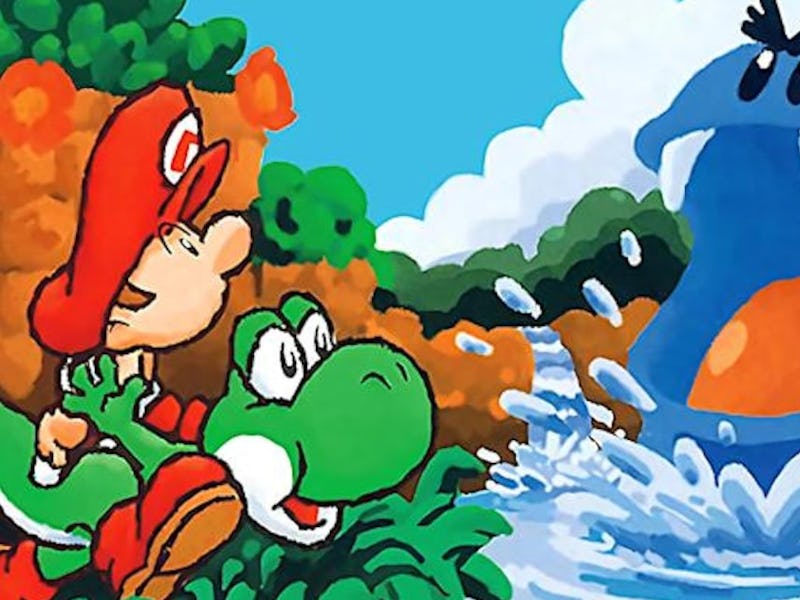Yoshi’s Island Is Still One Of Nintendo’s Best, Strangest Platformers
Adventures in babysitting.

Nintendo gave the SNES about as strong a start as you could hope for with Super Mario World. A continuation of its most popular series, the game built on everything that was already working for the series while introducing an overwhelming amount of new mechanics and fresh ideas. So how do you follow up what’s clearly one of the best platformers ever made, released at the very beginning of the console’s life? If you’re Nintendo, you spend four years developing a sequel that’s nothing like the original and doesn’t even star the same character — and somehow end up with another of the best platformers ever made.
Released on August 5, 1995, in Japan, Super Mario World 2: Yoshi’s Island is an incredibly bold swing. Where a straightforward rehash of Super Mario World with new levels would have worked, Nintendo instead went in an entirely different direction. In Yoshi’s Island, Mario has been turned into a baby, putting his dinosaur companion in charge. The powerups from Super Mario World are absent, giving Yoshi an entirely different set of abilities, and the game’s art style is entirely different. Yoshi’s Island was the final game in the Mario series on SNES, and the last before it transitioned to 3D on the Nintendo 64, and as unexpected of a sendoff as it is, it’s hard to imagine a better one now.
Yoshi’s Island makes Mario’s dinosaur companion into his protector.
While it’s numerically a sequel to Super Mario World, Yoshi’s Island is also a prequel to the entire Mario series. It starts with Mario and Luigi being dropped off by a stork, only for a member of the Koopa family to kidnap Baby Luigi. Baby Mario fares better, landing on the back of Yoshi, who sets off on a journey to rescue the missing Mario brother.
Its story alone is enough to make Yoshi’s Island stand out, but it also plays entirely differently from the rest of the Mario series. In Super Mario World, Yoshi has the ability to grab enemies with his tongue and spit them out, which is developed here into one of the game’s main mechanics. When Yoshi swallows an enemy, it turns into an egg and follows him around, ready to be used as a projectile later. And rather than just launching them straight ahead, Yoshi can now aim, which is a crucial part of solving puzzles.
But bigger than any individual abilities, the whole point of Yoshi’s Island is different from other Mario platformers. When Mario is hit by an enemy in other games, he loses a life. In Yoshi’s Island, getting hit instead launches Baby Mario off of Yoshi’s back, and a timer begins counting down to when the Koopas will return to steal him back. Yoshi only has a few seconds to scoop the future plumber back up before that happens.
Nintendo achieved the style of Yoshi’s Island by actually hand-drawing its art.
In a way, that makes Yoshi’s Island the first dad game. While Yoshi isn’t as moody as some of gaming’s other heroes, like God of War’s Kratos or The Last of Us’ Joel, he’s still motivated by saving his adopted son from peril in the same way. Or maybe, as strange as it sounds, a better comparison is Ico, a game whose entire point is protecting a defenseless person in your charge on a long escort quest. Yes, your character can be hurt, but the point of the game is the preservation of your companion, not your own safety. It’s rare for any game to make the player character a bodyguard more than a hero, and it’s doubly surprising to see that explored in its own adorable way all the way back on the SNES.
Nintendo didn’t skimp on the game’s aesthetics, either. Even before any of its gameplay innovation reveals itself, Yoshi’s Island sets itself apart solely with how it looks and sounds. Its soundtrack is a soft, cheery delight, with a lullaby for a main theme, but the game’s art style is the real marvel, carrying a unique hand-drawn style in a very literal sense. As character artist Hishashi Nogami told Kotaku in 2018, the game’s look was achieved by drawing images by hand, scanning them into a computer, then recreating them pixel by pixel to match the analog original.
Yoshi’s Island is an outlier in just about every way it can be. Switching up the series’ protagonist, gameplay, and art style all at once makes it one of the strangest Mario games ever made, and also one that feels as original today as it did when it first launched. While Baby Mario and Luigi have endured as characters in Mario Kart and other spinoffs, none of Nintendo’s other attempts to put Yoshi in a starring role have worked out quite as well as the first run. It’s a shame that Yoshi’s Island has never had a followup to match the original’s brilliance, but for a game that’s defined so much by its sheer creativity, maybe it’s fitting that it can’t ever be replicated.